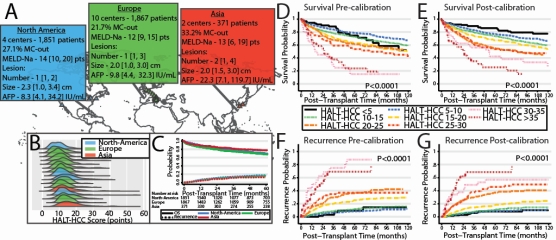Improving Prognostication amongst Patients Undergoing Liver Transplantation for Hepatocellular Carcinoma: An International, 16-Center Study to Validate and Recalibrate HALTHCC
1CCF, Cleveland
2MGH, Boston
3UCLA, LA
4UHN, Toronto, Canada
5SLH, Louvain, Belgium
6UH, Rome, Italy
7UP, Padua, Italy
8MUI, Innsbruck, Austria
9UCL, London, United Kingdom
10UM, Mainz, Germany
11SCH, Rome, Italy
12TVU, Rome, Italy
13AOU, Torrette Ancona, Italy
14AGH, Rome, Italy
15KU, Kyoto, Japan
16KU, Kyushu, Japan.
Meeting: 2018 American Transplant Congress
Abstract number: 544
Keywords: Allocation, Hepatocellular carcinoma, Liver transplantation, Prediction models
Session Information
Session Name: Concurrent Session: Liver: Hepatocellular Carcinoma and Other Malignancies
Session Type: Concurrent Session
Date: Tuesday, June 5, 2018
Session Time: 4:30pm-6:00pm
 Presentation Time: 4:42pm-4:54pm
Presentation Time: 4:42pm-4:54pm
Location: Room 6C
Objective: Prognosticating outcomes in liver transplant (LT) for hepatocellular carcinoma (HCC) continues to challenge the field. Whereas adoption of the binary Milan Criteria (MC) generalized the practice of LT for HCC and improved outcomes, its predictive character has degraded with increasing candidate and tumor heterogeneity. We sought to validate and recalibrate a previously developed, preoperatively calculated risk score, the hazard associated with liver transplantation in HCC (HALTHCC) in an international cohort.
Methods: This cohort from 2002-14 consisted of 4085 patients (both MC in and out [25.2%]) across 16 centers in North America, Europe, and Asia. A continuous risk score using pre-LT levels of alpha feto-protein, model for end stage liver disease sodium score, and tumor burden score was recalibrated amongst a randomly selected cohort (n=1016) and validated in the remainder (n=3079).
Results: This international study was used to adjust the coefficients in the HALTHCC score. Before recalibration, HALTHCC had the greatest discriminatory ability for overall survival (C-index=0.61) compared to all previously reported, preoperatively assessable scores. Following recalibration, the prognostic utility increased for both recurrence (C-index=0.71) and overall survival (C-index=0.63).
Conclusion: HALTHCC can be used to assess risk of poor post-LT outcome with greater accuracy than other competing scores and is easily generalizable around the world. Allocation policy adjustment incorporating candidate risk warrants further investigation.
CITATION INFORMATION: Firl D., Sasaki K., Kimura S., Dumronggittigule W., Gorgen A., Lerut J., Rossi M., Cillo U., Viveiros A., Tsochatzis E., Otto G., Ettorre G., Tisone G., Vivarelli M., Agnes S., Markmann J., Ikegami T., Kaido T., Sapisochin G., Agopian V., Lai Q., Aucejo F. Improving Prognostication amongst Patients Undergoing Liver Transplantation for Hepatocellular Carcinoma: An International, 16-Center Study to Validate and Recalibrate HALTHCC Am J Transplant. 2017;17 (suppl 3).
To cite this abstract in AMA style:
Firl D, Sasaki K, Kimura S, Dumronggittigule W, Gorgen A, Lerut J, Rossi M, Cillo U, Viveiros A, Tsochatzis E, Otto G, Ettorre G, Tisone G, Vivarelli M, Agnes S, Markmann J, Ikegami T, Kaido T, Sapisochin G, Agopian V, Lai Q, Aucejo F. Improving Prognostication amongst Patients Undergoing Liver Transplantation for Hepatocellular Carcinoma: An International, 16-Center Study to Validate and Recalibrate HALTHCC [abstract]. https://atcmeetingabstracts.com/abstract/improving-prognostication-amongst-patients-undergoing-liver-transplantation-for-hepatocellular-carcinoma-an-international-16-center-study-to-validate-and-recalibrate-halthcc/. Accessed December 17, 2025.« Back to 2018 American Transplant Congress

